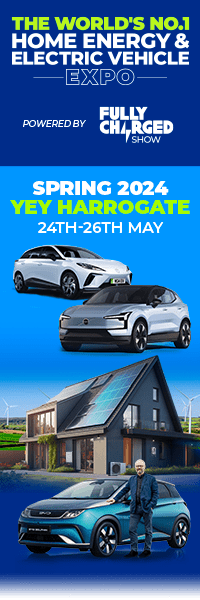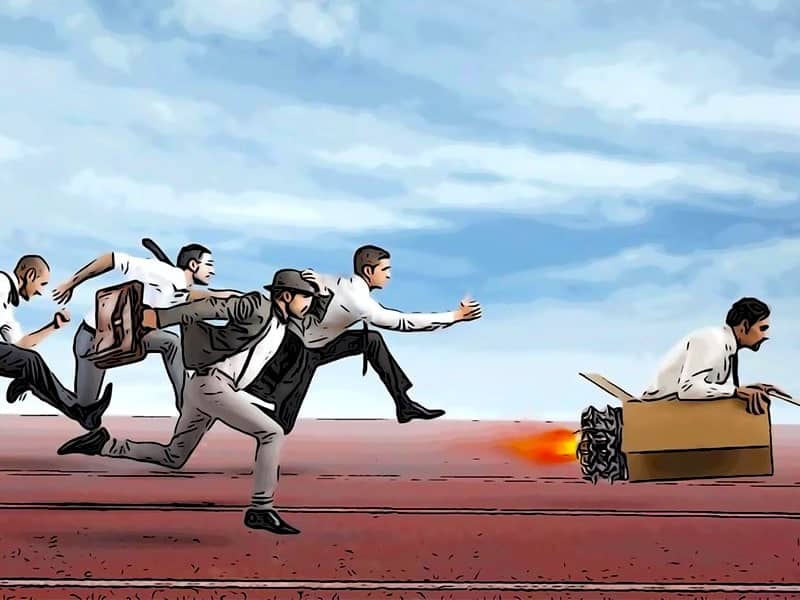
Tesla has made many mistakes on it’s journey to become today’s most valuable automaker, some leaving them teetering on the edge of bankruptcy. However, their competitors have made many more.

Expressing this in the words of Elon Musk,“You should take the approach that you’re wrong. Your goal is to be less wrong.” But if you listen to all other automotive CEOs all you’ll ever hear are their claims not to ever have been wrong at all.
The fundamental problem is not about making mistakes, because we all make mistakes and we learn from them, but if you make said mistakes more than once then, you’ve got a problem. To learn from your mistakes is the important trick but first of all you have to acknowledge that they happened. This is something every child learns from a young age and this is what the century-old automotive companies, and their experienced ‘grown-up’ CEOs, still have not yet learned. There are endless examples of peoples, countries, and companies that have failed because they’ve been unable to acknowledge their mistakes and most importantly, to learn from them.
The beautiful part of acknowledging that you have made a mistake is that it allows you to start over with new energy, power and focus to make this time round go better. Despite this, we often watch from the sidelines as incumbents try to improve something inherently flawed from the start, and investing time and resources into endless marketing and PR as an attempt to make the ugly look beautiful.
These high-level mistakes are endless but even more worrying is that the frequency of them never seems to decrease.
Mistakes are a form of positive development if you draw the right conclusions from them and choose to correct your course. If you continue to repeat the same mistakes, you should not be surprised when your company disappears sooner or later. To make mistakes is natural and if applied correctly, can turn into a win.
Nelson Mandela once said that people should not assess his life on what he achieved but on ‘how he managed to get out of a crisis’. The same should apply to incumbent automakers and because I am German, my special interest is the long-standing German automakers.
Below are a few examples of the many mistakes this automotive industry continues to repeat. Unfortunately, this list is not comprehensive (and will never be) because the creativity of inventing new ones exceeds my imagination. Generally, strategic mistakes have a long-lasting impact while tactical ones are short-term and can be more easily corrected.
1. Our brand value is a competitive differentiator
In a time of a technological transformation, the value your brand earned in the past, is almost worthless and ceases to matter. Every Dollar and Cent of it’s value needs to be regained and worked for, once again, as if the previous value never existed. Technologically speaking, in times of a paradigm shift, you’ll never be guaranteed the future you’ve spent the past working towards.
The value you believe to possess may be tightly tied to the legacy technology you’re inevitably forced to abandon. In this case, that value cannot be transplanted into the world of BEVs (Battery-Electric-Vehicle) easily. It’s akin to a complicated surgery, the outcome of which can go both ways: If the patient dies, you can’t claim it was a successful surgery, although some manufacturers, might. You can of course regain that brand value, and even extend it, that is if you manage to develop superior products, superior customer experience, and superior BEVs.
2. The competition are incumbents and not BEV start-ups
The scope and threat of competition for legacy automakers may have been understood when it comes to ICE (Internal-Combustion-Engine) vehicles but not to BEVs. It is not an enhancement of the same technology but an entirely new one, therefore you need a new strategy too. While most German automakers watched these developments (batteries, fuel cells, or e-Fuels) from their peers carefully, they did not take these new start-ups as a serious challenge at all but in fact, laughed and joked about them.
The ICE competition repeatedly reinforced the idea that nothing would change because they already made good profits and it’s impossibly hard to enter the ‘fold’ due to overwhelming amount of capital and reach you’d need even get started as an automaker.
In the last 60 years, over 50 automotive start-ups have tried, failed and disappeared. However, the assumption, by long-reigning Automakers, that this trend would continue indefinitely left them blind when it came to anticipating the rise of companies such as Tesla.
When Tesla’s first BEV, the Model S, launched in 2012, incumbent automakers believed it would remain a niche product. Regardless, the thought remained that the average consumer wouldn’t want a battery-electric vehicle (BEV) anyway. That assumption was of course, ‘confirmed’ later by market analysis surveys which posed such questions to a sample of consumers: who produced the expected responses – was confirmation bias at play? Regardless, consumers don’t know they want something until they they’ve experienced it, in some sense it’s fair to say that every ‘survey’ ever done on the uptake for a new technology paradigm shift is in itself contradictory.
3. It’s just a different drive-train
The perception that a BEV is like an ICE vehicle, with a different drive train isn’t just wrong, it’s rather short-sighted. This idea is believed and unfortunately perpetuated by management who understand sales, marketing, and ICE manufacturing but not battery technology and BEVs. The main aspects of a BEV are much broader, notably software and some integrations can allow vehicles to improve over time with OTA (Over-The-Air) updates. Each update can be used to improve the base product, current OTA updates from the likes of Tesla, have been known to improve on already impressive driving dynamics and efficiency. Similarly, a new subscription-based business model (resulting in a higher margin and lower total cost of ownership) is a disruption of its own. At the very least, two great reasons for a consumer to buy a BEV over an ICE counterpart.
The confusion about what a BEV is, and could mean for incumbent automakers, is a threat in its own right, to those unable to develop competitive BEVs or even counter measures fast enough to stand a chance.
The German Auto industry continues to struggle to bring a series of good BEVs to market because they need to adapt their organization appropriately to suit the intrinsic value of BEV production. The inner-workings of a consumable is often a product of the framework that built it. If the ‘software’ is missing in that framework or organization, it’s unlikely you’ll find it in the vehicle. At the base level, the value of a BEV platform is not always found in the hardware as is the case with an ICE car but instead the software. Therefore, the structure and scope of software should have strong and decisive power in all decisions made.
The extent to which this concept has been understood can be measured in the software board positions of German automakers that, until today, simply did not exist. Volkswagen is the only one that has considered installing such a role in 2021 despite previously firing a key software representative in 2020, potentially due to their dislike of him asking too many valid question. With just 10% of software developed in house at VW it’s too late and too little already.
4. Horizontal integration works in a technology transformation
For many decades’ automakers specialized in outsourcing everything and by using their massive purchasing power they’ve managed to reduce costs and increased their profits until suppliers started bleeding. This concept has worked well for them for decades, transforming them into profitable conglomerates comprised of sales and marketing departments that orchestrate the complex supply chain you see today. Their ‘spider-web-like network of support can be found in tens of thousands of low-cost suppliers they’ve worked hard to weave into the fold, however they’ve yet to realize that in outsourcing the knowledge and capability to do so could quite well turn into the web that traps them.
With the rise of BEV technology, they are now left with the seeds they have sown, to compete with their tens of thousands of suppliers against pure BEV start-ups like Nio or Tesla. The dependency on ICE supply chains limit the growth of their current business model and restricts the scope of R&D they have as the supplier orders book are full and their margins are slim.
If the only tool you’ve ever had is a hammer, then the only task you’ll ever see will be a nail. Consequently, the incumbents have only ever solved their problems by looking for someone else to supply BEV technology/software instead of improving their own vertical integration. This was, and still is, a strategic mistake. Suppliers will have little to no motivation to invest in BEV technologies for use in the next decade when they’ve got enough demand for existing components in the present.
To change an organizations distribution of manufacturing from horizontal to vertical is almost as taxing as building a start-up from scratch! Both require time and resources that the incumbents do not have. Vertical integration is especially important when it comes to hardware and software because the two need to work together seamlessly.
In a paradigm shift, methods of production intended to optimize on profits do not work – if anything it’s a strategic mistake which could easily leave you falling behind.
5. Incumbents will be the best BEVs manufacturers
The large ICE automakers have only ever been profitable thanks to their high capacity utilization and mass production. This is an unavoidable caveat when it comes to marketing globally-affordable products for both ICE vehicles and BEV. However, to believe that as a mass producer of ICE vehicles you’re also best positioned to produce BEVs en masse is another grave mistake.
BEV may look similar but the majority of core components (and the aforementioned digital infrastructure) is not. Executives and engineers all over the automotive industry have fallen into the same trap failing to understand the requirements and implications battery technology has on the engineering and manufacturing of a vehicle.
The outcome of this failure can be seen in the endless development interruptions and supply challenges; caused by everything from silicon chip shortages to battery supply limits. These issues coupled with the increasingly high cost of converting hundreds of ICE production lines into successfully operating BEV lines draws reason for concern. The financial investments required for this to happen smoothly are easily within the billions, not least helped by the fact that existing ICE production facilities are now essentially stranded assets: more of a burden than the advantage they once were. The oncoming tide forces incumbents to invest in both, adapting the old and installing the new, whilst stock markets and investors demand they retain their profitability.
6. Batteries are a commodity
These incumbent automakers repeat their mantra that batteries are a commodity and will be sourced from 3rd party suppliers. The choice to manufacture and pioneer battery technologies in-house (despite the upfront cost and complexity) would have left them with a competitive advantage and been the right strategy. The unwillingness to take this risk and to focus on short term profits (likely for their personal short term benefits) hinders their ability to focus on long-term success.
Realistically, a ‘shit-load’ of batteries is required to achieve BEV ‘success’ and product affordability, because all the incumbent automakers draw from the same few suppliers in unison, unaware Tesla has already positioned themselves as the largest customer globally, they cannot be surprised when they do not receive the volume of commodities they were hoping for.
In conclusion, the intrinsic value of batteries vs ICE components is the main differentiator. They have a unique selling point and currently they’re anything but a commodity.
7. No one wants autonomous vehicles
As we stated previously, consumers do not know what they want until they’ve had a chance to experience it. When it comes to autonomous driving experiences, the number of people who’ve had the opportunity to drive a ‘Level 2’, or even ‘Level 3’, autonomous vehicle are limited but those that have claim it to be a ‘phenomenal’ experience.
The hesitancy around accepting autonomy is only perpetuated by our fear of diminishing control. The idea that a separate entity will be deciding ‘what’s best for us’ and could indirectly harm us is an understandable, but frankly primal fear that fades once individuals are able to experience this technology, designed primarily to keep us safe. Many users who’ve been unfortunate enough to experience real-world incidents that require autonomous intervention have known that had they been in control it would have been unlikely they would have been able to react to or avoid said incident with the precision and speed of the autonomous system – sometimes resulting in life-saving outcomes.
Unfortunately, because +99% of us have not yet had the chance to experience autonomy we cannot easily eliminate this fear. Often what we don’t understand frightens us.
To many users, after a few hours of experience, this primal fear is subdued and users start to see the benefits of a world without the need for attentive driving and navigation.
8. Fuel Cells and Hybrids are good alternatives
Many automotive companies continue to invest in Hydrogen, Hybrid technology, or eFuels often labelling them as equally good alternatives. The majority of consumers will always have to make decisions based on a value for money proposition. If we assume for a second, although the battery drive train is in many ways superior, that every alternative drive-train offers the same value for money, consumers would then look for the most affordable option.
It is clear, but still widely unaccepted that the total energy consumption comparisons between drive trains show BEVs powered by renewable energy sources have the lowest cost and highest efficiency levels, resulting in the lowest TCO (Total cost of ownership) for consumers. If we include the maintenance costs for Hybrid technologies, Hydrogen options, or eFuel options in this comparison it becomes even more obvious that BEV’s are king.
The reduction in cost for BEVs will continue to accelerate unlike many alternative and legacy technologies. Another huge advantage is that a BEVs lifespan holds the lowest carbon footprint compared to its competitors. If we initiated a CO2 tax to compensate for the costly damage done to our environment then no one would seriously consider purchasing anything more impactful than a fully electric drive-train.
9. There is no demand for BEVs
Automotive managers have long claimed that there is no demand for BEVs and hence would only sell them if Governments provide appropriate incentives. While the entry price for a fully electric vehicle has been so far higher compared to an ICE vehicle, the dramatic decrease in battery cost over the last 2 years has suddenly made them more attractive for the majority of consumers look to make a purchase based off TCO (Total cost of ownership).
Aside from price, the electric drive-train has other unique selling points: The instant responsiveness, improved handling (thanks to lower center of mass), enhanced, zero-emissions, up-to date technologies and a quieter ride.
10. Software Is a Commodity you buy best from Suppliers
Software is still considered from incumbent automakers to be like a chassis part you buy from a supplier and assemble. Over decades, software engineers had a minor and powerless position while the value of automakers creation has been solely found in the gearbox, drive train, and brand. In the world of BEVs, the value creation can be found mainly in the software which puts the world of incumbents, upside down.
Because a BEV is comprised of intertwined software and hardware that needs to work seamlessly together, every interface you have creates challenges, issues, costs and reduces innovation cycles.
The hardware-driven automakers need to convert to software-driven agile organizations that deliver incremental value every other week with over the air updates and subscriptions. Such a transformation is a gigantic endeavor and it’s questionable if all will make it.
The incredible volume of major strategic mistakes made is high and the damage done in the last 15 years too severe to claim it won’t have a profound impact on incumbent automakers.
To believe they will remain like we know them from the past is an illusion.
About the author
Alex Voigt has been a supporter of the mission to transform the world to sustainable carbon free energy and transportation for 40 years. As an engineer, he is fascinated about the ability of humankind to develop a better future via the use of technology. As a German, he is sometimes frustrated about the German automotive industry and its slow progress with battery electric vehicles which is why he started to publish in English and German. With 30 years of experience in the stock market, he is invested in Tesla [TSLA], as well as some other tech companies, for the long term.










